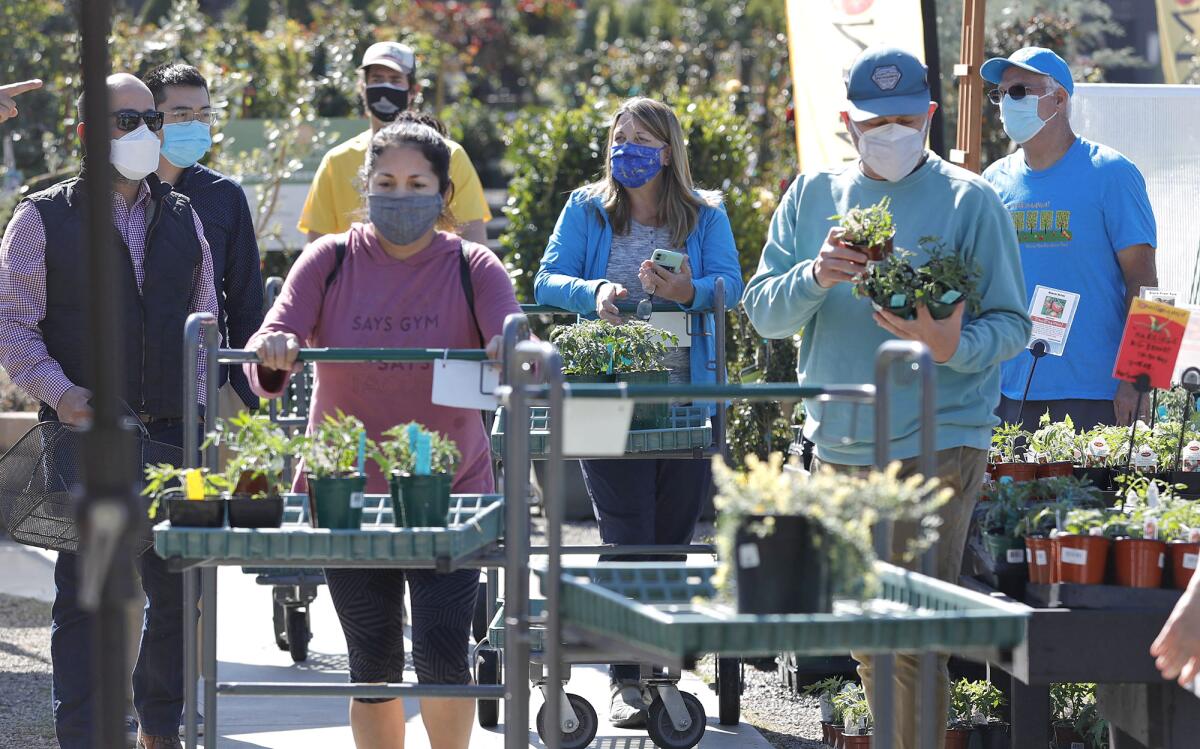Orange County survey shows views on mask-wearing, climate change taking a left-hand turn

- Share via
Despite its reputation as a Republican holdout with intractable views on coronavirus mask mandates, climate change and the results of the 2020 U.S. presidential election, the real viewpoints of Orange County may be more liberal than one thinks.
That was the takeaway of a survey conducted by Chapman University that assessed the impressions of 703 Orange County residents during a three-week period in February.
The survey found 83% of respondents considered the coronavirus a “real threat,” while 70% favored a national mask mandate. An overwhelming majority of residents — 80% — said they’d already gotten the COVID-19 vaccine or planned to get it.
And, although much rhetoric and skepticism about government overreach during the pandemic is routinely broadcast on local conservative social media outlets, nearly three-quarters of respondents said they believed government coronavirus mandates have been “about right” or did not go far enough.

Chapman University political science Professor Fred Smoller, who crafted questions for the 2021 Orange County Annual Survey released March 1, said the study intends to gauge the populace on important matters of public policy.
“The county needs to know itself,” Smoller said in an interview Monday. “Decision-makers have to know what’s going on — the survey is a way of doing that.”
Smoller culls data from each year’s survey to find trends compelling enough to drive discussions at an annual Public Policy Conference hosted by the university’s Wilkinson College of Arts, Humanities, and Social Sciences. After a 2020 hiatus, this year’s virtual event, “Fighting Climate Change,” takes place April 7.
“Most polls are done by someone who has an agenda. My view is wanting to provide public policy makers information that is not just anecdotal,” Smoller said “And we’ve found the county is not nearly as conservative as its portrayal in the national media.”
Orange County voter data show Democrats inched past Republicans in 2019 to claim the greatest number of registered voters by 89 individuals. That slim margin widened last year to more than 52,000 voters.

But the number of Orange County residents registered as having “no party preference” — currently standing at 436,260 voters and constituting 21% of the voting public — has historically obscured the true divide between the county’s liberals and conservatives.
Chapman’s survey sheds light on how independent voters stood on more partisan issues, such as the soundness of the recent presidential election and support for the Black Lives Matter movement.
A question about whether the November election was fairly conducted split Democrats, 97% of whom responded affirmatively, from Republican voters, only 33% of whom agreed. Among no-party voters, 73% said the election process was fair.
When asked whether they supported or opposed Black Lives Matter as a cause — another question that split Democrats (95% supporting) and Republicans (22% supporting) — 73% of independent voters said they did.
About 73% of no-party voters also said they favored a nationwide mask mandate, compared to 94% of Democrats and 39% of Republicans.
Respondents also shared views on reopening schools, the effort to recall Gov. Gavin Newsom and police performance, issues that returned more evenly split responses but failed to deliver an overwhelming conservative majority opinion.
Mike Moodian, a leadership studies lecturer at Chapman, said the county has changed since the days of its association with conservative stalwarts like John Wayne and the anti-communist John Birch Society.
“O.C. today is diverse both culturally and politically,” Moodian said in a release issued after the survey was publicized. “[It] is increasingly looking like the rest of the country, as opposed to being an ultra-conservative outlier among coastal California communities.”
Smoller said despite that, the county’s representation in national media — from newspaper editorials to TV shows like “The Real Housewives of Orange County” — continues to drive stereotypes that may no longer be true.
“The image of the extreme is something the press likes,” he added. “I’m surveying, to borrow the phrase, the silent majority.”
Ahead of the April 7 policy conference on climate change, Smoller and his team found 73% of survey respondents believed actions should be taken to address global warming.
More than half supported Newsom’s commitment to ban combustible fuel vehicles by 2035, and 58% favored a law requiring 100% renewable energy in California by 2045.
Smoller hopes decision-makers will consider the Orange County Annual Survey and make changes people want to see, rather than deepen political entrenchments.
“If you make public policy and don’t listen to public opinion, it’s like flying a plane without radar,” he said.
All the latest on Orange County from Orange County.
Get our free TimesOC newsletter.
You may occasionally receive promotional content from the Daily Pilot.




